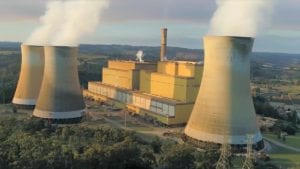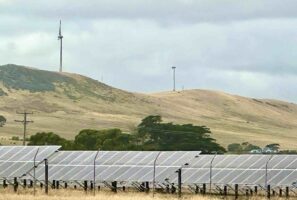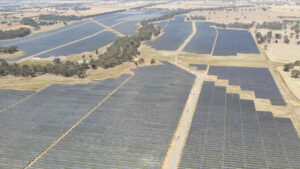Chief scientist Alan Finkel is widely expected to lay out various policy scenarios for Australia’s energy industry when he presents his report to COAG leaders on Friday, but perhaps the most profound impact of his report will be how it can shape the discussion of the future of the industry.
Australia’s energy policy has been bogged down by the idea that “baseload” power – from spinning turbines powered by burned fossil fuels – is the only source of cheap, reliable and dependable power.
This myth, propagated by industry incumbents, conservative ideologues and the just-don’t-knows, is one of several often rolled out in an attempt to demonise the impact of variable renewable energy sources such as wind and solar, and roll back ambitious emissions or renewable energy targets.
Finkel is likely to try to reset the discussion. He needs to.
His preliminary report gave a major taste of what he calls the “unstoppable transition” of our energy system that would be based around the consumer rather than centralised generation.
“It is the antithesis of the centralised energy model”, he said then. And he continued along this line in an appearance at a Senate Estimates committee last week.
Asked by Labor industry spokesman Kim Carr if his recommendations about the operations of the electricity system would include “base load” power, Finkel responded:
“I prefer to use the word ‘reliable’, but not because there is something intrinsically wrong with ‘base load’. The challenge is not the kind of power it is but can it be delivered when it is needed and securely?”
Senator KIM CARR: That is right.
Dr Finkel: The combination of reliable and secure means that you can operate the system for large industrial consumers and for everybody—
Senator KIM CARR: Will the aluminium industry look to your report with confidence in terms of security of supply?
Dr Finkel: Yes.
This is critical. We have seen in the past week the fears and misconceptions of Australia’s manufacturing industry about the issue of “baseload power”.
Bluescope Steel’s Paul O’Malley was on Radio National breakfast on Thursday morning arguing that a focus on emissions or renewable energy would amount to all jobs and industry leaving the country. “It’s really easy, if we don’t want jobs in Australia, let’s make emissions reduction a number one priority,” he said.
O’Malley said this at the same time as apparently embracing the “clean energy target”, that according to modelling commissioned by the Climate Change Authority would bring 70 per cent renewables by 2030, the same as other scenarios such as renewable energy target or government legislation.
(For the record, we think the modelling commissioned by the CCA is absolute rubbish. It is based on nonsensically high assumptions about the cost of wind and solar, and somehow imagines that geothermal energy will make a miraculous re-appearance and play a dominant role, or that solar will all but disappear after 2020. It even imagines new coal generation (unabated) after 2040. We pray that Finkel is producing his own modelling, based on some up to date assumptions about the cost of wind and solar, the cost of integration, and of gas).
The assumption that coal is the cheapest power source is being propagated by the likes of Tony Abbott, still influential within the large conservative rump in the Coalition. “Coal is by far the cheapest form of baseload power,” Abbott said on 2GB radio on Wednesday.
Not so, says Finkel. In that Senate estimates hearing he noted: “The actual cost of bringing on new coal in this country per megawatt-hour is projected to be substantially more expensive than the cost of bringing on wind or solar.”
And this leads to what will be an important argument from Finkel – away from the traditional idea of “base-load” coal to something like the “base-cost renewable concept” concept promoted by Michael Liebriech, from Bloomberg New Energy Finance.
“The new way of doing things will be about locking in as much locally available base-cost renewable power as possible, and then supplementing it with more expensive flexible capacity from demand response, storage and gas, and then importing the remaining needs from neighbouring grids,” Liebrich wrote in January.
He was pointing to the plunging cost of wind and solar across the world, to below $US30/MWh, and still falling. In Australia, wind is down to $A52/MWh, and solar close to $A70/MWh, and falling quickly. Both are well below the average cost of wholesale power set by the coal and gas generators.
“Putting super-cheap, “base-cost” renewable power at the heart of the world’s grids in this way will require a revolution in the way the electricity system is regulated,” Liebrich writes.
He says the current progress of renewables has been based around subsidising or mandating its installation, while forcing the rest of the system to provide flexibility, and this has taken renewable energy to 20,30, or 40 per cent in some markets.
“But it won’t work when it comes to 60, 70 per cent or higher. That would mean a smaller and smaller proportion of conventional power generation has to provide a larger and larger amount of flexible supply for which it was never designed.
“We are reaching the point in the story where power system regulation will have to be fundamentally rethought. Simply layering on a capacity market is the wrong response: creating guaranteed demand for obsolete technologies has never ended well.”
And that is the message that Finkel needs to make clear to federal and state policy makers, the energy industry, and the large energy consumers such as Bluescope, BHP and Glencore, all still attached to the notion of baseload coal, and to households.
Actually, the households get this, having produced a lot of their own electricity with rooftop solar, and now looking to store it. As the CSIRO, the network lobby, and the Australian Energy Market Operator have all pointed out, this will be the basis of the future grid.
If the CCA modelling is right, and the country is headed towards 70 per cent renewable energy by 2030, then the system has to be rethought.
The Clean Energy Finance Corporation had a go at this and produced this graph to illustrate how renewables will provide the “base cost” variable generation, supplemented by storage, and other balance of systems such as demand response.
 Some of this dispatchable generation could come initially from gas peakers, or as AEMO boss Audrey Zibelman prefers, smarter and cheaper solutions such as demand management and energy efficiency.
Some of this dispatchable generation could come initially from gas peakers, or as AEMO boss Audrey Zibelman prefers, smarter and cheaper solutions such as demand management and energy efficiency.
Remember, it is the spiralling cost of gas peakers, and the bidding practices by their owners, that are responsible for Australia’s current surge in wholesale prices.
Changing the system, as Zibelman points out, requires a reset of market rules, let alone business models and fuel sources.
Liebreich had a go at this in a blog he wrote in May. He recommends clearly-defined, separate markets for variable power and dispatchable power. The delta between the variable and firm price is then the “Firm Spread” – the true value of dispatchability at key locations in that particular market.
This spread will be very low in any market that has not yet saturated in terms of variable renewables, and where there is a lot of existing flexibility at little or no incremental cost.
But it will rise rapidly in markets where there is so much solar and wind that the spot price for variable power is crashing to near-zero or even sub-zero at sunny/windy times, and where restricted operating hours drive the cost of flexible generators up.
It can be expected to drop again over time, as technological innovation – particularly in battery storage – makes firming cheaper and the premium for firm power is reduced.
“It is Firm Spread that is the motor needed to drive innovation in technologies with the potential to turn cheap variable power into affordable dispatchable power,” Liebriech writes.
It will be interesting to see what Finkel produces, because he is sure to touch on the issue of energy security and how dispatchable generation will be encouraged.
We can be sure that the overriding message will be clear: Australia needs to shift quickly to a smarter, cheaper, cleaner and more reliable grid. Baseload coal won’t just disappear overnight, but it has no long-term future in that scenario.
Note: Please read this explainer of a Low Emissions Target by the ANU’s Frank Jotzo. It is important to note that the benchmark for a LET, say of 600kgCO2/MWh is not necessarily a carbon intensity target. But that target – and the way the scheme is structured – will decide whether it is good policy or not.











